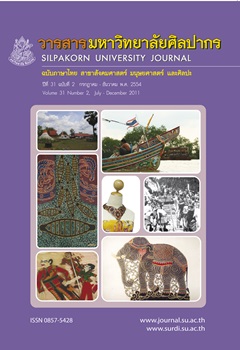การบริหารจัดการคณะวิทยาการจัดการ มหาวิทยาลัยราชภัฏ The Management of Management Sciences Faculty, Rajabhat Universities
Main Article Content
Abstract
บทคัดย่อ
การวิจัยครั้งนี้มีวัตถุประสงค์ 1.) เพื่อศึกษาระดับการบริหารจัดการคณะวิทยาการจัดการ มหาวิทยาลัยราชภัฏ 2.) เพื่อศึกษาปัจจัยที่มีความสัมพันธ์กับการบริหารจัดการคณะวิทยาการจัดการ มหาวิทยาลัยราชภัฏ 3.) เพื่อวิเคราะห์การพยากรณ์การบริหารจัดการ คณะวิทยาการจัดการ มหาวิทยาลัยราชภัฏ 4.) เพื่อนำเสนอรูปแบบการบริหารจัดการ ที่มีความสัมพันธ์กับการบริหารจัดการคณะวิทยาการจัดการมหาวิทยาลัยราชภัฏ วิธีการศึกษาประกอบด้วยการวิจัยเชิงปริมาณ โดยการสุ่มตัวอย่าง จากอาจารย์คณะวิทยาการจัดการ 40 แห่ง ทั่วประเทศ จำนวน 338 ตัวอย่าง และทวนสอบข้อมูลเชิงปริมาณด้วยการสัมภาษณ์เชิงลึกคณบดีและทีมผู้บริหารคณะวิทยาการจัดการจำนวน 11 ท่าน เครื่องมือที่ใช้ในการรวบรวมข้อมูลเป็น แบบสอบถาม สถิติที่ใช้ในการวิเคราะห์ข้อมูล ค่าเฉลี่ย ค่าส่วนเบี่ยงเบนมาตรฐานสัมประสิทธิ์สหสัมพันธ์เพียรสัน (Pearson’s Product Moment Coefficient) การวิเคราะห์การถดถอยพหุคูณแบบขั้นตอน (Stepwise Multiple Regression Analysis)ผลการวิจัยพบว่า 1.) ในภาพรวม คณะวิทยาการจัดการ มีการบริหารจัดการอยู่ในระดับดี และพบว่าในทุกด้านที่ศึกษา คือด้านการเรียนการสอน ด้านการวิจัย ด้านการบริการวิชาการแก่ชุมชน และด้านการประกันคุณภาพมีการบริหารจัดการในระดับดีเช่นเดียวกัน 2.) ปัจจัยที่มีความสัมพันธ์ กับการบริหารจัดการเรียงระดับความสัมพันธ์ดังต่อไปนี้ ภาวะผู้นำ (r = .737) คุณภาพบุคลากร (r = .688) คุณภาพเทคโนโลยี (r = .642) ความสามารถของบุคคล(r = .508) ปริมาณเทคโนโลยี (r = .642) ค่านิยม (r = .468) วิสัยทัศน์ร่วม (r = .516) การเรียนรู้เป็นทีม (r = .481)งบประมาณ (r = .676) ความคิดอย่างเป็นระบบ (r = .499) กรอบความคิด (r = .516) 3.) ตัวแปรอิสระทั้ง 6 ตัวซึ่งประกอบด้วย ภาวะผู้นำ คุณภาพบุคลากร คุณภาพเทคโนโลยี ความสามารถของบุคคล ปริมาณเทคโนโลยี และค่านิยม สามารถพยากรณ์การบริหารจัดการได้ร้อยละ 69.70 (R2=0.697 F=126.707 ที่ระดับนัยสำคัญทางสถิติ เท่ากับ.01) 4.) รูปแบบที่นำเสนอประกอบด้วยตัวแปรอิสระที่สามารถพยากรณ์คณะวิทยาการจัดการได้ทั้ง 6 ตัวแปร
คำสำคัญ: 1. การบริหารจัดการ. 2. ภาวะผู้นำ. 3. คุณภาพบุคลากร. 4. คุณภาพเทคโนโลยี.5. ความสามารถของบุคคล. 6. ปริมาณเทคโนโลยี. 7. ค่านิยม.
Abstract
The objectives of this research are 1.) to study levels of effective management of the ManagementScience faculty, Rajabhat Universities, 2.) to study correlation of effective management and other variablesof the studies. 3.) to examine the significant variables in predicting the effective management levels,4.) to propose the management models associated with those levels. The method of study comprisedquantitative analysis by sampling techniques from many instructors from 40 Rajabhat Universities in Thailandwith 388 samples, and verified quantitative data techniques by indepth interviews of the Dean and ManagementTeams from the Faculty of Management Science, amounting to 11 persons. Tools used for data collecting arequestionnaires with analytical statistics, Mean, Standard Deviation, Pearson’s Product Moment Coefficient,and Stepwise Multiple Regression Analysis.The research results revealed that the Faculty of Management Science, in general, is effective at ahigh level, with regard to learning and teaching techniques, research, and academic services for communities.In addition, the quality assurance is at a high level. With regard to the management performance, themanagement techniques sequential by relationship are as follows: Leadership (r =.737), quality of personnel(r = .688), quality of technology (r = .642), personnel’s competency (r = .508), quantity of technology(r = .642), value (r = .468), mutual vision (r =.516) learning in teams (r = .481), budget (r = 676), systematicthinking (r = .499), conceptual framework (r = .516). The six independent variables, comprising leadership,quality of personnel, quality of technology, personnel’s competency, quantity of technology, and value areable to predict the Management Performance at 69.70% ( R2 = 0.697, F=126.707 with a significant levelof .01). The model presented consists of the independent variables that are able to predict the managementperformance of all of six variables for the Faculty of Management Science.
Keywords: 1. Management leadership. 2. Quality of personnel. 3. Quality of technology.4. Personnel’s competency. 5. Quantity of technology. 6. Value


